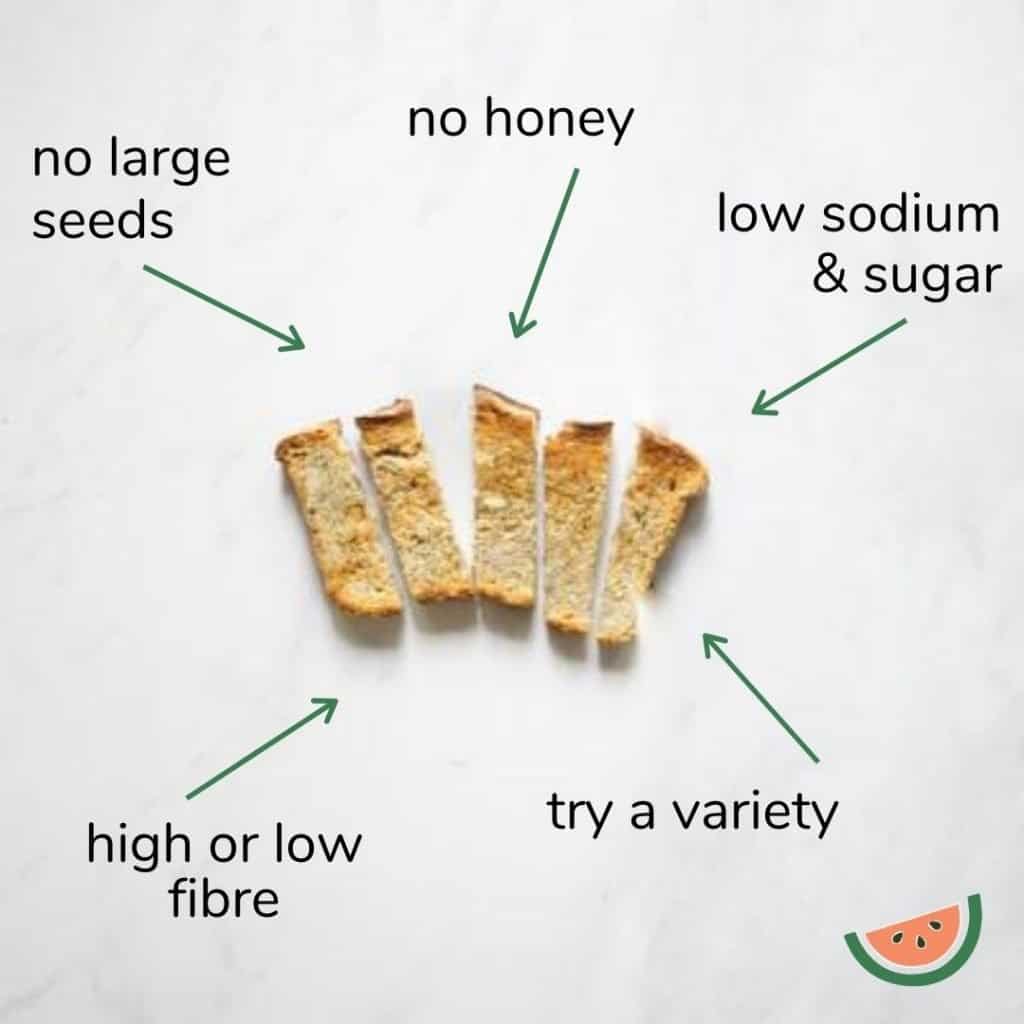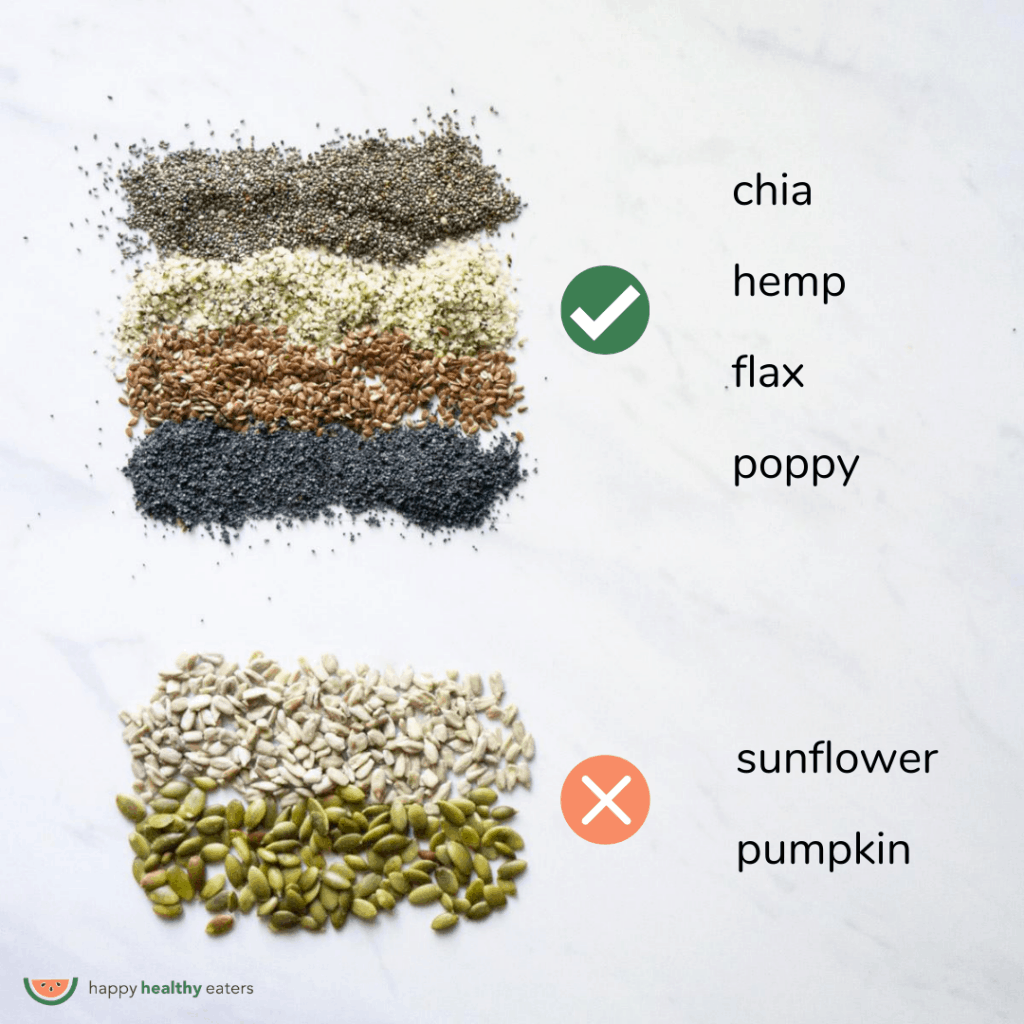In this article we’re going to give you everything you need to know about buying, preparing, and serving bread to babies!
But first, you’ll need to know….
When can babies start eating bread?
While babies could theoretically start to eat bread at 6 months, they don’t need bread from a nutritional point of view. The main nutrient babies are missing in their diet at 6 months is iron, so we recommend focusing on getting your baby used to eating a repertoire of high iron foods first, then expanding their palette! High iron foods would include meat, eggs, & beans (to name just a few). Our course has an entire section dedicated to iron if you’re feeling overwhelmed!
Having said that…. On the flipside, if a baby is not taking a quick liking to the high iron foods, toast strips with high iron spreads can actually be a good vehicle to introduce them to some of these foods! (examples of toast toppings listed below)
For lack of a better analogy, the toast “dilutes” the strong flavour of other foods, making it more readily accepted by those discriminating palettes.
I (Jessica) even did this as a young adult staying with a host family in Guatemala. I was a super picky eater but didn’t want to offend my hosts. They usually served buns with dinner so if there was something that I was finding difficult to choke down, I would stuff it inside a bun. They probably got the idea that Canadians have super weird eating habits because of me!
How to prepare bread for babies
The baby led weaning movement has changed the whole world of infant feeding! Recent research shows that offering babies handheld foods starting at 6 months is just as safe as starting off with purees! With one caveat: parents need to know how to modify foods to reduce the risk of choking.
When it comes to bread, taking a slice out of the bag and handing it to baby poses a major choking risk!
Go ahead and try this if you want: if you take a slice of bread and ball it up in your hand, you’ll end up with dough… it will look as though it wasn’t even baked yet! This “dough ball” could form in your baby’s mouth and become a choking risk.
To prevent this “dough ball” from forming, we have a very simple solution for you:
Toast the bread!
Toasting will cement the structure of the bread and then it will simply dissolve in baby’s mouth instead of potentially creating a round, ball shape that baby could choke on.
To make the toast easier for a young baby to bring to their mouth, slice it into adult finger sized strips!
How to shop for bread for babies

Babies have unique nutritional needs so there are a few things you want to take into consideration when choosing a bread to buy for baby! Keep these points in mind and you’ll find the best bread for baby.
1 Low sodium
Since babies’ kidneys aren’t developmentally ready to handle much sodium before 12 months, it’s important to keep your baby’s food choices relatively low in sodium. Sodium is one of the two minerals that make up salt. When you think of going low salt you probably think about avoiding processed foods and avoiding adding salt to any recipes. You may be surprised to hear that bread is a “salty” food! Aim for a bread that has less than 150-175mg sodium per slice.
2. No large seeds
In the same way that nuts are choking hazards for babies, so are the larger seeds such as pumpkin seeds (pepitas) and sunflower seeds.
3. Smaller seeds are 100% fine
Smaller seeds are perfectly okay though and offer a lot of added nutrition! Seeds contain iron, other minerals, and some have omega 3 fatty acids, which are important for baby’s brain development.
The following seeds are a-okay to find on the bread ingredient list since they are so itty bitty:
- Chia seeds
- Poppy seeds
- Sesame seeds
- Flax seeds
- Hemp hearts

4. Skip the honey
Check the ingredient list to ensure there isn’t any honey, as honey poses an Infant Botulism risk. It doesn’t matter if the honey is raw, pasteurized, or baked; the spores to the Clostridium Botulinum bacteria are heat resistant! Babies’ guts are not ready to battle the toxin that’s released from these spores. While the chance of botulinum spores actually being found in honey isn’t very high, the consequences are severe. Infant botulinum can result in death. And since there’s literally no other benefit for babies to consume honey, why take the chance?
5. High or low fibre; it’s your choice
While we generally recommend sticking to high fibre breads for adults, babies have high energy needs so it’s okay to switch things up and offer them some lower fibre options sometimes too. This is especially true if baby is being raised in a vegan household. Sometimes children in a plant-based diet end up getting TOO much fibre. For adults looking to reduce their total intake, one of the strategies we recommend is to increase fibre intake. Fibre fills your tummy but doesn’t get broken down for energy… it travels to the large intestine where the bacteria there break it down for their energy needs. So for kids, with high energy needs, too much fibre can actually cause them to be in a calorie deficit!
6. Look for low sugar
Unless you’re making sourdough bread from scratch, it can be hard to find a bread with 0 added sugar. But while you’ll generally find an added sugar in the ingredient list, the manufacturers don’t typically use a lot. They put a little bit in to help kickstart the yeast into action. Look for 1g of sugar or less per slice.
7. Aim for variety
Honestly.. can you list anyone you know who doesn’t love bread? For this reason, bread can be a great way to introduce new flavours to your baby. If they already know and love one type of bread, introducing them to a new flavour is a nice bridge and helps increase your baby’s palate for unique flavours.
Some varieties to try:
- Rye
- Multi-seed (small seeds only)
- Sourdough
- Pumpernickel
- Spelt
And, of course, if you make your own bread the options are endless!
Ways to offer bread to baby
Bread can be so fun for babies! Here are some ideas for toast toppings!
- Egg salad (mash the yolk of a hardboiled egg with some breastmilk and your favourite herbs or spices)
- Meat “paté” (soft cooked meat blended with breastmilk and cooked veggies) like Baby Beef Stew
- Nut and seed butters (thinly spread)
- Mashed black beans with salsa
And the following are all recipes found in our Whole Food Recipes for Your Baby E-book:
- Baby Hummus
- Carrot Tahini Dip
- Cashew Cauliflower Dip
- Coconut Lentil Curry
- Green Pea Guacamole

Want more resources for feeding your baby?
We’ve put together a Rescue Resource package that’s full of handy printables that you can post on your fridge or inside your cupboard door for easy reference.
Inside the package you’ll find:
- How to Serve Veggies for Babies
- How to Serve Fruit for Babies
- How to Introduce The Top 10 Food Allergens
- Everything You Wanted to Know About Babies and Iron
- Handy Baby Signs to Learn for Feeding Baby
- 3 Week Sample Menu for Starting Solids
- How to Prepare a Balanced Baby Meal
- How to Adapt High Risk Choking Foods
- … and more!
The Rescue Resources comes packaged with our e-courses and virtual workshops or you can purchase it á la carte.







2 thoughts on “When Can Babies Eat Bread? [+best bread for babies]”
How much sodium should a 24 month old be having per day? Google giving mixed reviews and seems impossible to stay under limit with sodium in everything (bread, cream cheese, hummus, cheese, crackers)
The recommendation is about 800mg/day.